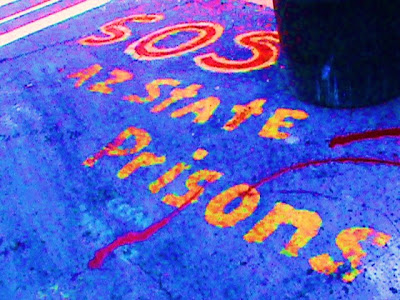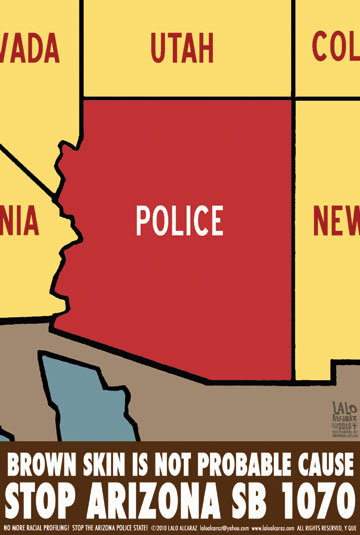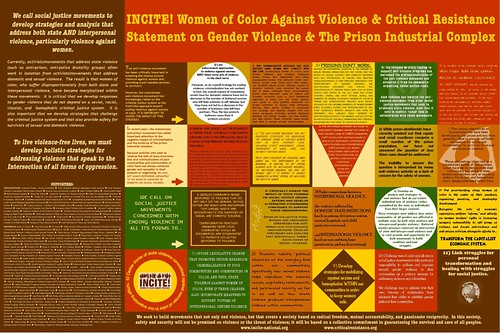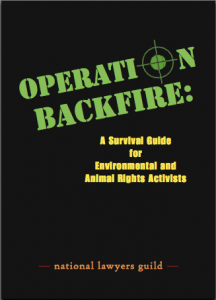Neither the City of Phoenix nor the negotiators appointed by the Occupy Phoenix General Assembly to interface with them seemed pleased with my decision. Nor did the police - three of whom in succession approached me to warn me that I was violating the Phoenix Camping ordinance and could be arrested. The third cop was most emphatic - at which point I began yelling to the crowd for help:
"Mic Check!" "Mic Check!" (that's how you signal you need the floor and the group lets you know when you have it). I hollered that my tent was in protest against the camping ordinance and the criminalization of homelessness, and asked them to protect me from being arrested. I pointed out that if I was a tired, 47-year old woman with no place to sleep and no energy to walk any further, I could be arrested for laying down there to sleep - and that's anywhere in Phoenix. The crowd converged and the cops backed down.
I began talking more about the city's homeless but was cut off by a couple of apparent organizers or representatives of the larger collective trying to de-escalate the potential for a conflict with the cops. Even as one officer was threatening me with arrest, my comrades were reassuring the gathering crowd that an agreement had just been reached with the city that no one would face arrest for putting up a tent (only later did we learn that was only for so long as the park would be open - after closing we were arrested for just being there).
 Away from the circle, after erecting my tent, I asked members of the negotiating team (I think that's who they were, anyway) to please seek amnesty for all the campers in Phoenix that night, not just us. Unfortunately, I'm not sure that part was heard. I'm hoping we can get the abolition of the camping ordinance on the larger group's agenda - more likely, now, I think, that more people have experienced first hand a small taste of the police harassment that our homeless brothers and sisters get on a regular basis.
Away from the circle, after erecting my tent, I asked members of the negotiating team (I think that's who they were, anyway) to please seek amnesty for all the campers in Phoenix that night, not just us. Unfortunately, I'm not sure that part was heard. I'm hoping we can get the abolition of the camping ordinance on the larger group's agenda - more likely, now, I think, that more people have experienced first hand a small taste of the police harassment that our homeless brothers and sisters get on a regular basis.photo by robert haasch (who saved my ass by being there)
I went on to provoke the police a little more that night just before the mass arrests. Unlike most of my fellow occupiers, I was not seated and linking arms with the group - I was out filming the columns of riot police sweeping the park. Another protester, Cody (our flag handler) and I strayed too far from the collective and into the path of the police, and got nabbed early on. They yelled a warning right at us that if we didn't leave the park we'd be arrested (that was pretty clear), but before I managed to take two steps back I was apprehended by Officer Chad Shiply (at least, that's who got the credit on my booking papers) - in fact, I think he was yelling at me ("you in the red hat") even as our warning was being issued.
Cody got pretty roughed up when they tackled him - I think he was hit in the head and they kept yelling at him to let go of his flagpole, all the while pinning it between his body and his arms. A cop stepped so hard on his neck that he was wheezing all the way to jail, and his flex cuffs were on so tight he lost feeling in his hands.
Whoever it was who arrested me wasn't very gentle, either, by any means - my left arm is pretty bruised up from where he twisted it behind and under some piece of equipment (it felt like the rim of a riot shield, but I don't think he was carrying one), and the skin around my wrist is broken from where he put the flex cuffs on too tight. I told him it was cutting me, but his answer was simply "It's supposed to be tight", and put me in the wagon. I got another cop's attention, though, and he and a couple of other officers tried to cut it off, only to find that it was so digging deep into my skin that they couldn't remove it until we got to the station where they had a special tool. They loosened the pressure by cutting the other piece off my right hand and pulling out my bracelet from under the remaining plastic band, putting me in regular cuffs for the ride.
From there on out, any mistreatment I was subjected to was the same that all the other prisoners I was with was subjected to: extremely cold cement slabs and floors to discourage sleep or even simple comfort, over-crowded and filthy holding cells, and two meals of barely-edible food (an oatmeal creme cookie, a small container of peanut butter, two small loaves of funky bread, two moldy decorative oranges, and a "blue hug" - the syrupy concoction that's also known as "bug juice", to those of you who went to summer camp). Being moved from one cell to another repeatedly and never finding ourselves in the view of a clock or window, we were constantly disoriented as to time and space.
Only a couple of our guards seemed to enjoy abusing their power and being mean; most were just matter-of-fact or indifferent to prisoner complaints and questions, and in the course of giving us orders - although some were curious about our protest and increasingly bemused at the crowd growing outside the jail awaiting our release. I felt blessed that we were kept together; I so needed the company of the other women who chose this same path. They kept my spirits up, and my heart warm.
That's saying a lot, given my condition. I reported upon intake what medications I needed every day, but didn't get any of them. With my thyroid level falling Sunday morning, I spent most of the time shivering in a deep freeze. I don't know if denying me two doses of my mood stabilizers made much of a difference, but I sure had moments of pretty deep demoralization and despair. At the very least it threw me off my schedule; I skipped a few beats.
I didn't even bother asking for aspirin or motrin for my headache - that seemed to be the least of my worries. I was exhausted, stressed, and my body temperature and mood were crashing hard. I was acutely aware that it would not look good to my judge, if informed, that I already have a case in municipal court for another act of civil disobedience involving 3 charges of criminal damage. I felt incredibly vulnerable to being trapped there, and missed my Mom so much that I silently cried.
Some of you who know me well are aware that while I was a delinquent and trouble-maker from a young age, I was never criminalized. Instead, for using drugs, running away, and trying to kill myself so often I spent my adolescence locked up in psychiatric institutions, being rehabilitated instead of just punished. Relapse part of the recovery process from alcoholism and addiction (I started drinking at 13), so while I was a traumatized, deeply depressed youth, I could have also easily gone through the juvenile justice system (like my big brother) and landed in prison at 18 for all my drug-related crimes. Instead I pretty much sobered up and became a responsible citizen at 20. With my history of institutionalization, my mood disorder, my addictions, and lack of any resources by which to survive, I could have so easily lived and died like Marcia Powell - there but for the grace of God go I.
Now, at 47 years old, I'm more radical than I was as a teen. I think that's because I see what's at stake for the people so much more clearly now - not just what's at stake for me. This was my first arrest and booking into the county jail. It was a disturbing experience, even though endured with friends and comrades - I don't look forward to this again. I'm afraid that given the persistence of my disobedience I'm likely to end up doing more than a few hours next time, if there is one.
Though I haven't been arrested before, I have been confined as a patient. No matter how good the conditions or how kind my keepers are, I never much liked being treated like a prisoner, which is what being a psychiatric patient entails as well - only our sentences and subjugation to a higher authority on the appropriateness of our conduct are indeterminate and not subject to effective appeals - nor does our imprisonment garner much public sympathy. Think about it: it's just not the same trying to rally people to "free Peggy" if I'm in the nut house than if I'm in jail for taking on the riot police - few people are willing to second-guess the good judgement of anyone who calls themselves a mental health professional and declares one of us to be a danger to ourselves or others.
With limited rights as subjects in mental health court, we can be placed under surveillance of the psychiatric system indefinitely, be forcibly injected with mind-altering drugs that stay in our system for weeks at a time, be deprived of some of our civil rights (like convicted felons), and be violently seized by police and put back into state custody without even being suspected of a crime. It's chilling to know how easily they can still do that to me - especially since I walk a fine line some days between outraged artistic expression and just plain madness.
That does not mean I really aspire or prefer to take a stroll through the criminal justice system as a defendant, though. I just felt that in both cases an act of civil disobedience was essential to bring attention to serious problems that the law enforcement community, for one, needs to take some responsibility for. That means everyone from the beat cop on the street to the head of the Maricopa County Superior Court should be part of the conversation about the escalating violence and despair in the state prisons, and the tragic deaths of so many people who never should have even gone there - like people who are criminalized for their mental illness or housing status.
Prisoners like Shannon Palmer and Marcia Powell could have been helped long before heading to prison with outreach and supported housing programs, like we developed in the 1990's. If prosecutors like Bill Montgomery want to reduce both victimization and criminalization, they'll support more resources going into our mental health system than into building new prisons, and cops should support legislative changes that take them out of the role of social workers by insuring social workers are around to prevent crisis from escalating to police attention.
Anyway, I'm now in rather deep trouble, I think, over too many minor infractions, and must behave myself - so next time you hear me taking on the Phoenix police, remind me to chill myself out. I've been booked, printed and detained once already - I even have a mug shot now (I'm a serious criminal here). I'm really kind of a wimp, and don't want to go through that all again.
I'll still be out there, though - just not fighting with the police. Look for me chalking Power downtown or handing out Real Cost of Prison comic books, promoting the November 30 ALEC Resistance. The people need to tune into that one quick if they really want to make a difference in our current social state.
For those of you doing any kind of jail support for Occupy Phoenix, by the way - I think we all have our arraignments on October 26, 2011 at 10am (phoenix Municipal Court 300 W. Washington St). At that time some may both plead guilty and be sentenced, hopefully to time served (or have a sentencing date set). Some will no doubt plead not guilty and ask for a bench trial (no jury for misdemeanors like this). We have to be facing probable jail time or probation in order to be appointed an attorney if we can't afford one. Since there could be up to six months of jail time and a huge fee involved, I'm asking for an attorney, myself. In any case, a little support for us defendants that day (I believe there were 46 arrested) would be appreciated.
In the meantime, there are stipulations to our freedom (these are mine, anyway). The first one is the only one that worries me, since that can be subject to interpretation at the discretion of a cop...but at least she didn't order us to stay away from the scene of the crime:
1. Obey all laws.
2. Appear at all court hearings and follow all court orders.
3. Notify the court if you move from the address listed on the complaint.
4. Do not harass or threaten alleged victims, witnesses, and/or arresting officers.
Remind us to stay out of trouble please, folks. We won't be released on PR again if we don't. There's a whole lot of damage we can do without being criminal anyway, and we need to be employing a diversity of tactics, as the anarchists often say - and not everyone can afford to be arrested. To those of you who think you can - please be careful not to get hurt out there. The cops can be brutal, and it's really no fun going to jail. Here are some tips if you expect to be arrested, though:
- Don't let any of what I just said scare you from taking action: we really need more arrestable citizens willing to step up when others get taken out. Just go in with your eyes wide open.
- Give all your stuff to a friend ahead of time who can greet you as you come out - they'll probably need to take you to the impound of the police department that arrested you. Just keep your license handy - everything else, including your shoelaces, will have to go.
- Have your jail support team planned out, including some clue about the possible legal consequences you may face, and where, other than the PD's office, you can get legal assistance.
- Write the phone numbers you may need with a Sharpie on your arm - including the person you need to drive you. You may want to include the number of a bailbonds-person, too. I'll post a link to one when I hear of a good one to refer you to. The jail staff are NOT likely to let you pull any numbers off your cell phone, so be prepared.
- be well-layered for your action, erring on the side of being too warm. Everyone is freezing in jail, and there's nothing soft on which to sit or put your head. Extra, warm clothes are priceless.
- save all food you are given, even the moldy oranges. You may get hungry enough to eat it before they feed you again, or another prisoner may come in without having had food in days.
- bond with your comrades and fellow prisoners, to the extent they are comfortable doing so. It makes the time pass and can pull you out of your own misery. Almost everyone was in a worse predicament there - with more to lose - than me.
- let supporters know it could be up to 24 hours before you even see a judge, so they aren't hanging from the get-go. Tell them when your initial appearance is scheduled for, and that they probably won't be able to get you until 2 hours after that - if you get released. Again, my little stay was about 18 hours from pulling into the jail to my release.
- once free, getting your property will probably take time - it may take your entire workday. Be careful what you promise your employer - you may not have your car keys in the am following your release (if at night or on a weekend), and need to deal with all that.
- and, this should go without saying: don't talk to or trust the police, before or after an action, be it solitary or a collective one. Their job is to shut us down - period. They'll do it with their gas and clubs or simply with their smiles - the latter is most insidious. Don't let them in your head either way.
Arrests made after Phoenix occupy protests
About 50 Occupy Phoenix protesters descended on the Fourth Avenue Jail in Phoenix to support the 45 demonstrators arrested early Sunday. "Bankers get a bailout and we get jail," they chanted before marching back to Cesar Chavez Plaza on Sunday afternoon.
Later that evening, about 150 demonstrators crowded the sidewalks at the plaza under the watch of police officers. Three demonstrators were arrested when they refused to get off the street after the plaza's closing hour.
In the early hours of Sunday, Phoenix police arrested 45 Occupy Phoenix protesters who refused to leave downtown's Margaret T. Hance Park at its 10:30 p.m. closing time, according to Phoenix Police Sgt. Trent Crump.
Marking the first time the group staged a demonstration in Phoenix, more than 1,000 members of a movement that decries corporate greed among other issues demonstrated at Cesar Chavez Plaza in downtown Phoenix before moving to the park.
But unlike in cities such as New York, where Occupy Wall Street protesters have been given the okay since last month to camp out on a privately owned parcel, Phoenix riot police forced protestors out of the park and arrested those who wouldn't go, Crump said.
"Most of those arrested were passive in nature and no injuries were reported to either officers or demonstrators," Crump said.
The arrests capped a day that saw more than 1,000 people packed Cesar Chavez Plaza in downtown Phoenix to protest what they view as abuses by banks and other major corporations.
The protest was an offshoot of the Occupy Wall Street movement that spread Saturday to cities such as Raleigh, Denver, Seattle, Chicago and Tucson, where several hundred people rallied at Military Plaza Park.
Like the New York crowds, Occupy Phoenix protesters championed diverse causes, united by grievances against corporate greed and political influence.
The targets of protesters' anger ranged from Washington, D.C.'s partisan politics to the abuse of children by Catholic priests.
Protesters blame these problems on wealthy corporate CEOs and what they termed big businesses' lack of compassion for the "lower 99 percent" of the population.
Earlier Saturday, the protest went smoothly, Crump said.
"There were large crowds with no known injuries or arrest. The plaza had cleared out late in the afternoon, prior to its 6 p.m. closing time," Crump said of the earlier gathering. Protestors Saturday afternoon marched to Hance park, in part because of its later hours of operation, which are posted as 10:30 p.m.
"As the park closing hour passed many of the demonstrators refused to leave," Crump said.
Detectives from the Phoenix Police Community Response Squad personally urged group members to leave quickly. More requests made by ground and by air.
"However, a large group remained and refused to leave the park," Crump said.
Before midnight, Field Force Team moved in to clear the protesters, whose chants and other loud noises prompted police reports, Crump said.
The team formed a line and moved across the park, arrested and pushing the protesters ahead of the line, Trump said. Sprinklers came on and many demonstrators moved north, Crump said.
As of this morning, 45 arrests had taken place for criminal trespass, a Class 3 misdemeanor, Crump said.
"Most of those arrested were passive in nature and no injuries were reported to either officers or demonstrators," Crump said.
Despite the arrests protesters vowed to return today in force, but by early Sunday just a few clustered near the Cesar Chavez Plaza.
The gathering was primarily organized through social media, and the movement has no official spokesman.
"Non-violence is really good practically," said Carolyn Vesecky, a trainer with the Phoenix Nonviolence TruthForce. "We have a lot of passion, but we need to direct it in the most constructive means."
About a dozen musicians played instruments, sang and rapped revolutionary lyrics at various times.
When they closed the park, the police flew their chopper past midnight, and by 1:30 had pushed everybody out of the park. Protesters said that Phoenix Assistant Manager Cavazos made the problem worse by pushing the protesters out of the park into neighborhoods in the middle of the night.
By Sunday afternoon, the crowd at Cesar Chavez Plaza had swelled to a couple hundred people, some of them yelling, "We love you," to motorists driving on Washington Avenue and waving signs that read, "We are the 99 percent," "End the Corpocracy," and, "Money is not speech. Corporations are not people," a reference to the controversial Supreme Court decision known as Citizens United.
Several wore T-shirts with the epigram, "Think: It's not illegal yet."
Among the demonstrators was Dave Reilly, 47, of Chicago, who had been in Occupy protests in New York and Chicago before he came to Phoenix.
Reilly had been a training coordinator for an electronics corporation but lost his job in 2007 because the company switched to less-expensive online training.
"I've been looking for work; it's a black hole," said Reilly, who has worked part-time jobs including pedaling a rickshaw, cleaning toilets and working as a lifeguard.
He worked construction in Phoenix for two months but quit after he didn't get a paycheck.
"They shrugged and said, 'When we get paid, you get paid.' People are so desperate, employers are taking huge advantage of the situation. They can replace you; somebody else will come along and do the job for free."
Still, he carried a sign saying "I (heart) USA" explaining his sign by saying, "It's the greatest country in the world; it's just a little bit mismanaged."
Among the protesters was Ondi Scibilia. She said she had been living in Santan Valley, but her home is being short-saled, so she's staying with a friend in Goodyear.
Her green-cleaning/concierege company was doing well until the economy tanked. It folded in December 2008.
Scibilia grew vegetables and goats for cheese on her land, but her husband lost his job with a cement company in December 2009, and in 2010, their marriage ended.
She has turned in hundreds of job applications, which have prompted only two phone calls and one interview.
"I still have hope," she said. "Without hope, I wouldn't be breathing."
Sylvia Trainor of Peoria is two weeks away from losing her house to auction. Until she lost her well-paid engineer husband to cancer, the couple paid still paid the mortgage from their savings.
She's in deep debt because of his cancer treatments but says she can't get coverage under AHCCCS, the state's Medicaid system, not even for her son who has Asperger's syndrome, a form of autism.
"All I have is Social Security," she said. "If I pay the mortgage, I don't have enough money for food. I get food boxes, but that's not enough with four children at home."
When she loses her home, she wants to keep her family together, so she expects to pitch a tent in a park.
"The only thing holding me together is my faith," she said.
Also at the protest Sunday night was Peter Szayer of Mesa, who had just spent 18 hours in the Fourth Avenue Jail after being arrested for being in Hance Park after it closed.
"It put things in perspective how things are run here in Arizona in the jail system," said Szayer, who was a college student but had to quit because he couldn't afford school.
He now works as a caregiver to physically and mentally challenged people at Tungland Corp. in Phoenix.
He said he was put in pink handcuffs, had the option of sleeping on the floor or a concrete bench, and was fed once - bread, peanut butter and two small oranges.
"I could totally tell they did not care about us," he said. "They didn't care how big or small our crime was. I was sitting next to a guy (not one of the protesters) who was bleeding all over the place."
He said detention officers made fun of him and his fellow protesters, taunting them by saying, "Are you having fun occupying this jail?"
Szayer said he faced the prospect of being homeless Sunday night because his backpack containing his car keys, cellphones and ID had been impounded and he couldn't retrieve them until Monday.
He was concerned because he said he needed an ID to get them.
"It's something I'll have to deal with tomorrow," he said Sunday night.


































